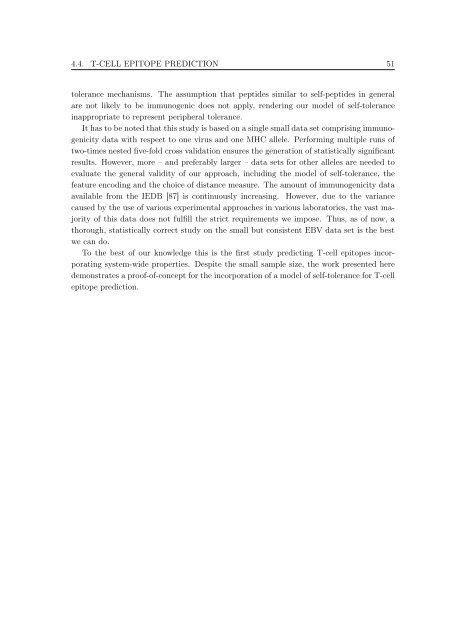New Approaches to in silico Design of Epitope-Based Vaccines
New Approaches to in silico Design of Epitope-Based Vaccines
New Approaches to in silico Design of Epitope-Based Vaccines
You also want an ePaper? Increase the reach of your titles
YUMPU automatically turns print PDFs into web optimized ePapers that Google loves.
4.4. T-CELL EPITOPE PREDICTION 51<br />
<strong>to</strong>lerance mechanisms. The assumption that peptides similar <strong>to</strong> self-peptides <strong>in</strong> general<br />
are not likely <strong>to</strong> be immunogenic does not apply, render<strong>in</strong>g our model <strong>of</strong> self-<strong>to</strong>lerance<br />
<strong>in</strong>appropriate <strong>to</strong> represent peripheral <strong>to</strong>lerance.<br />
It has <strong>to</strong> be noted that this study is based on a s<strong>in</strong>gle small data set compris<strong>in</strong>g immunogenicity<br />
data with respect <strong>to</strong> one virus and one MHC allele. Perform<strong>in</strong>g multiple runs <strong>of</strong><br />
two-times nested five-fold cross validation ensures the generation <strong>of</strong> statistically significant<br />
results. However, more – and preferably larger – data sets for other alleles are needed <strong>to</strong><br />
evaluate the general validity <strong>of</strong> our approach, <strong>in</strong>clud<strong>in</strong>g the model <strong>of</strong> self-<strong>to</strong>lerance, the<br />
feature encod<strong>in</strong>g and the choice <strong>of</strong> distance measure. The amount <strong>of</strong> immunogenicity data<br />
available from the IEDB [87] is cont<strong>in</strong>uously <strong>in</strong>creas<strong>in</strong>g. However, due <strong>to</strong> the variance<br />
caused by the use <strong>of</strong> various experimental approaches <strong>in</strong> various labora<strong>to</strong>ries, the vast majority<br />
<strong>of</strong> this data does not fulfill the strict requirements we impose. Thus, as <strong>of</strong> now, a<br />
thorough, statistically correct study on the small but consistent EBV data set is the best<br />
we can do.<br />
To the best <strong>of</strong> our knowledge this is the first study predict<strong>in</strong>g T-cell epi<strong>to</strong>pes <strong>in</strong>corporat<strong>in</strong>g<br />
system-wide properties. Despite the small sample size, the work presented here<br />
demonstrates a pro<strong>of</strong>-<strong>of</strong>-concept for the <strong>in</strong>corporation <strong>of</strong> a model <strong>of</strong> self-<strong>to</strong>lerance for T-cell<br />
epi<strong>to</strong>pe prediction.

















